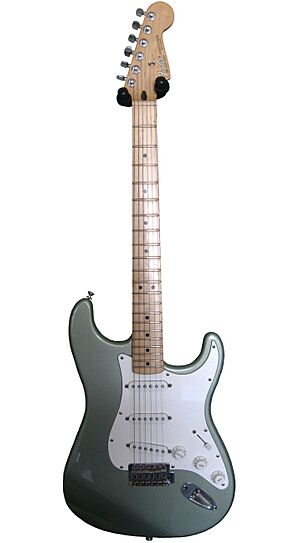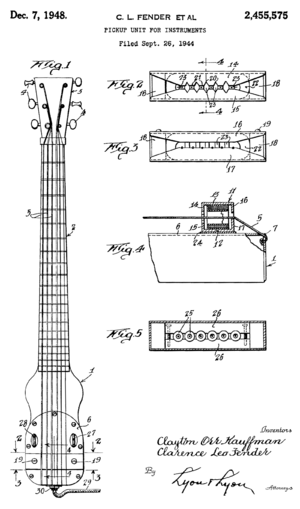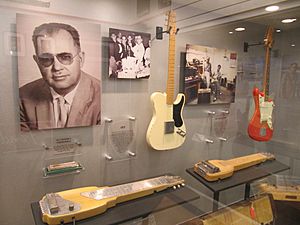Fender (company) facts for kids
 |
|
|
Formerly
|
Fender Electric Instrument Manufacturing Company |
|---|---|
| Private | |
| Industry | Musical instruments |
| Founded | 1946 in Fullerton, California, U.S. |
| Founder | Clarence Leonidas Fender |
| Headquarters |
Los Angeles, California
,
U.S.
|
|
Area served
|
Worldwide |
|
Key people
|
Andy Mooney (CEO) Matthew Janopaul (CFO) Evan Jones (CMO) Aarash Darroodi (CLO) |
| Products |
|
| Brands |
|
| Owner | Servco Pacific |
| Divisions |
|
The Fender Musical Instruments Corporation (often called Fender) is an American company. It makes and sells musical instruments and amplifiers. Fender is famous for its solid-body electric guitars and bass guitars. Some well-known models are the Stratocaster, Telecaster, and Precision Bass. Clarence Leonidas "Leo" Fender started the company in Fullerton, California, in 1946. Today, Andy Mooney is the CEO, a role he has held since 2015.
In 2020, Servco Pacific became the main owner of Fender.
Contents
The Story of Fender Guitars
How Fender Started
The company began in late 1938 as "Fender's Radio Service." Leo Fender was an expert in electronics. He fixed radios, record players, and sound systems. He also repaired musical instrument amplifiers. These early amplifiers used special tubes to make sound louder. Leo also rented out sound systems and sold records.
Leo Fender noticed problems with the amplifiers musicians used. He started building his own amplifiers. He also changed existing designs to make them better.
By the early 1940s, Leo Fender teamed up with Clayton Orr "Doc" Kauffman. They formed the K & F Manufacturing Corp. Their goal was to design and sell electric instruments and amplifiers. They started making Hawaiian lap steel guitars and amplifiers in 1945. These were sold together as sets.
Leo soon realized that making instruments was more profitable than fixing them. He decided to focus on manufacturing. Doc Kauffman wasn't sure about this, so they went their separate ways in 1946. Leo then renamed the company the "Fender Electric Instrument Company."
The first product of the new company was likely a lap steel guitar made in 1946. It had an early version of the famous Fender logo.
In the late 1940s, Fender started trying out new guitar designs. Early Broadcaster guitars had issues. Their one-piece maple necks sometimes bent in humid weather. Fender then added a metal truss rod inside the necks. This allowed musicians to adjust their guitars easily.
Mass production of the Telecaster began in 1950. Its neck was bolted on, which made it easy to build. The body and neck could be made separately. Then, workers could quickly put them together.

In 1950, Fender introduced the first widely produced solid-body electric guitar. It was the Telecaster (or "Tele"). After its success, Fender made the first mass-produced electric bass. This was the Precision Bass (P-Bass). In 1954, Fender showed off the Stratocaster (or "Strat").
Leo Fender used ideas from musicians to design the Stratocaster. After the Stratocaster came out, the Precision Bass was updated. It was made to look more like the Stratocaster.
In 1959, Fender released the Jazzmaster guitar. This guitar looked very different from earlier designs. It had a unique body shape and new electronics. It was made for the Jazz music market. However, jazz musicians didn't use it much. Instead, it became popular with surf rock bands. This led to the Jaguar guitar in 1962. The Fender Jazz Bass came out in 1960.
When Fender Changed Hands
In January 1965, Leo Fender sold his companies to CBS (Columbia Broadcasting System). The sale was for $13 million. Many people thought this was a good thing. CBS had a lot of money and could help Fender grow. They bought many Fender parts and guitars.
However, the quality of Fender guitars started to go down under CBS. CBS focused on cutting costs. After 1965, some cosmetic changes happened. Guitars got a larger headstock shape. Necks with block-shaped position markers were added in 1966. Amplifiers got a bolder black logo and a brushed aluminum face.
Other changes included a new "tailless" Fender amp decal. Some amplifiers got a sparkling orange grillcloth in the mid-1970s. For guitars, the four-bolt neck joint changed to three bolts in 1971. A second string tree was added in 1972. These changes were meant to save money. But some musicians felt they made the guitars less reliable.
During the CBS years, Fender did introduce some new designs. The Fender Starcaster was unusual. It had a semi-hollow body but kept the traditional Fender bolt-on neck. It also had a new pickup called the Wide Range pickup. This pickup led to new versions of the Telecaster. These were the Telecaster Custom, Telecaster Deluxe, and Telecaster Thinline.
Guitars made before 1965 (called "pre-CBS" models) are generally more sought after by collectors. In 1966, Fender opened a much larger factory. Guitar and amplifier production grew a lot under CBS.
In 1981, CBS brought in new leaders. They were John McLaren, William "Bill" Schultz, and Dan Smith. They had experience in the music industry. They needed to fix the quality problems. The Fender factory in Fullerton was almost shut down to improve manufacturing. Fender also had to compete with cheaper copycat guitars. So, they decided to move some production to Japan. Fender Japan Ltd. was started in 1982.
In 1983, the Fender Stratocaster got a new design for a short time. It had a single tone control and new pickups. After selling Fender, Leo Fender started two new companies. These were Music Man in 1975 and G&L Musical Instruments in 1979. Both made electric guitars and basses based on his later ideas.
Fender Becomes Independent Again
In 1985, Fender employees bought the company from CBS. This was led by Bill Schultz. They renamed it "Fender Musical Instruments Corporation" (FMIC). The old factory in Fullerton was not part of the sale. So, FMIC built a new factory in Corona, California. Most Fender guitars sold in 1985 were made in Japan.
In 1987, Fender opened a small factory in Ensenada, Baja California, Mexico. By 1990, Fender and its Japanese partners started making guitars there. Mexican-made Fenders appeared in catalogs from 1991. The plant was rebuilt in 1994 after a fire. Today, models like Player, Vintera, and Acoustisonic are made there.
In 1991, FMIC moved its main office from Corona to Scottsdale, Arizona.
Fender's Cool Logos
The Fender "spaghetti logo" was used from 1954 to the mid-1960s. By 1965, Fender used a thicker gold-and-black logo. This logo is linked to the CBS era.
Fender's Family of Brands
Fender Musical Instruments Corporation (FMIC) has bought many other instrument brands. These include the Guild Guitar Company, Sunn Amplifier Company, and SWR Sound Corporation. In 2003, FMIC started making and selling new Gretsch guitars. Fender also owns Jackson, Olympia, Orpheum, Tacoma Guitars, Squier, and Brand X amps.
In 2007, Fender bought Kaman Music Corporation. Kaman owned brands like Ovation Guitar Company, Latin Percussion, and Charvel. Kaman also sold Sabian Cymbals and Takamine Guitars.
In 2011, Volkswagen worked with Fender. They made special sound systems for Volkswagen cars in North America.
In 2015, Kaman Music Corporation was sold to Jam Industries.
In 2019, Fender bought the Bigsby Electric Guitar Company. Bigsby makes the popular Bigsby vibrato tailpiece.
In 2021, Fender bought PreSonus Audio Electronics. PreSonus makes professional audio equipment and software.
In 2023, Fender announced a partnership with Kevin Shields from the band My Bloody Valentine (band).
What Fender Makes
Fender's main products are electric guitars. Some popular models are the Jaguar, Jazzmaster, Mustang, Telecaster, and Stratocaster. They also make bass guitars like the Mustang, Jaguar, Jazz, and Precision models.
Fender also makes acoustic guitars, lap steel guitars, banjos, and amplifiers. They used to make the Fender Rhodes electric piano. In addition, Fender produces effects pedals and picks.
According to guitar expert George Gruhn, the Telecaster, Precision Bass, and Stratocaster are very important. They are "three of the most important models in the history of the electric guitar." Fender also makes and sells all musical instruments under the EVH brand. This includes replicas of the famous Frankenstrat.
Squier: Affordable Guitars for Everyone
Squier was a company that made strings. Fender bought Squier. Since 1982, Fender has used the Squier brand to sell cheaper versions of Fender guitars. This helps them compete with copies of the Stratocaster. Squier guitars have been made in the United States, Japan, Korea, Indonesia, and China.
Images for kids
See also
- Music Man
- G&L Musical Instruments




